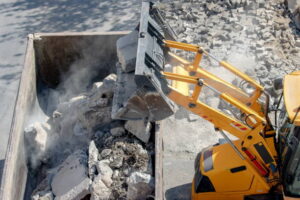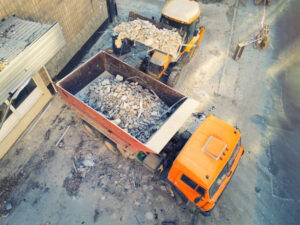The construction industry generates more waste than any other sector, yet many contractors still view debris management as an afterthought rather than a strategic business component. With the EPA estimating that 600 million tons of construction and demolition debris were generated in the United States in 2018—more than twice the amount of generated municipal solid waste—and construction waste accounting for about 40% of the world’s total solid waste, effective waste management has become critical for project success.
In today’s competitive construction landscape, where project delays not only increase costs but can also damage reputation, leading to a loss of future business, professional junk removal services have evolved from a convenience to a strategic necessity. This comprehensive guide explores how strategic debris management can transform contractor operations, boost productivity, and enhance profitability.
The Magnitude of Construction Waste: Understanding the Challenge
Staggering Statistics That Demand Attention
The scale of construction waste generation is both alarming and opportunity-rich. Annual construction waste is expected to reach 2.2 billion tons globally by 2025, representing an enormous logistical challenge for contractors worldwide. Construction and demolition waste represents at least 30% of solid waste generated globally, making it one of the largest waste streams in the world.
The financial implications are equally significant. The construction and demolition waste management market is set to grow to $271.68 billion in 2028, with the global market size estimated at USD 209.5 billion in 2023 and expected to grow at a compound annual growth rate (CAGR) of 5.7% from 2024 to 2030. This growth reflects both the increasing volume of construction activity and the rising demand for professional waste management solutions.
The Hidden Costs of Poor Waste Management
From residential renovations generating 6 pounds of waste per square foot to commercial projects producing 4.5 pounds per square foot, debris accumulation can quickly overwhelm unprepared contractors. Over 75% of construction waste holds untapped value and isn’t currently being repurposed or recycled, representing both environmental waste and missed economic opportunities.
The productivity implications are severe. Studies have found that the average worker on a jobsite only spends about 30% of their time on productive work, while the other 70% is spent on inefficient processes like tracking down the latest plans or getting assignments. Poor debris management contributes significantly to these inefficiencies, creating obstacles that reduce overall jobsite productivity.
How Professional Junk Removal Transforms Contractor Operations
Enhanced Operational Efficiency
Professional junk removal services fundamentally transform how contractors approach project management. Outsourcing junk removal boosts team efficiency, allowing crews to focus on the project while junk vendors handle cleanups. This focus shift enables contractors to allocate their skilled labor to revenue-generating activities rather than waste management tasks.
Professional junk removal dramatically boosts business efficiency by freeing up employee time that would otherwise be spent on non-productive activities like waste management. By outsourcing debris disposal, firms can better allocate their manpower’s time and energy to crucial business functions, thereby enabling them to strive for a more profitable bottom line. For many businesses, time saved on waste management translates into valuable, revenue-generating time.
Streamlined Project Workflow
Construction debris removal services are most effective when integrated into the project’s workflow rather than treated as an afterthought. Professional services understand construction sequencing and can coordinate removals to minimize disruption. A missed pickup or delayed haul can trigger a cascade of inefficiencies—subcontractors may need to pause work, materials can’t be delivered to cluttered areas, and inspections might be delayed due to safety violations. To prevent this, junk removal providers often establish service level agreements with builders that outline expected pickup frequency, communication protocols, and emergency response options.
Space Optimization and Site Organization
One of the key benefits of regular junk removal is space creation. Workplaces often find themselves accumulating piles of waste, which can make the environment feel cramped and impact overall productivity. By hiring professional junk removal services, businesses can effectively reclaim this space, creating a more organized and clutter-free environment.
A safer jobsite is a more productive jobsite. When the work area is clean, clear, and free of hazards, crews can work more efficiently with fewer interruptions. Establishing and enforcing good safety practices improves productivity and helps teams focus on project-related tasks.
The Economics of Strategic Debris Management
Cost-Benefit Analysis: Investment vs. Returns
Many contractors initially view junk removal as an additional expense, but the financial analysis reveals a different story. While it’s reasonable to think that doing junk removal yourself saves money, this is not often the case. Handling junk removal yourself will take longer than hiring an experienced team and can raise the risk of injury and overtime pay. Debris removal will not only take away from your crew’s time and effort but will be more expensive than outsourcing.
Hiring a junk removal service may seem like an added expense, but it can be more cost-effective in the long run. Without the need to rent trucks, purchase supplies, or pay landfill fees, clients often find that professional services offer better value.
Hidden Costs of DIY Debris Management
The true cost of self-managed debris removal extends beyond the obvious expenses. Junk removal requires a truck rental to transport debris and waste, and the disposal of construction materials requires many fees and regulations. Construction debris removal costs range from $66.70 to $78.00 per cubic yard as of August 2024, with costs usually based on the volume or weight of debris removed rather than per square foot.
When factoring in labor costs, equipment rental, disposal fees, and lost productivity, the total cost of DIY debris management often exceeds professional service costs. Dumping fees typically sit between $50 and $100 per ton, with prices going up significantly for hazardous waste disposal due to special considerations that drive up disposal fees.
Professional Service Pricing Models
Junk removal costs vary based on the type of unwanted item, method of disposal, and company, but most charge between $200 and $800 for this service, with most jobs ranging from $75 to $800 and an average cost of $250. When charged by the truckload, the cost to remove construction waste ranges from $100 to $800.
For contractors managing large projects, professional junk removal services cost $300 to $1,000 per load and offer the convenience of handling everything for you, while dumpster rental costs $220 to $780 per week and requires your time and hard work.
Productivity and Timeline Benefits: The Competitive Edge
Construction Productivity Crisis
The construction industry faces a significant productivity challenge. According to the global Construction productivity report, construction labor productivity has averaged only 1 percent annually over the past two decades. In comparison, for the same period, global labor productivity for manufacturing was 3.6 percent.
The industry is lacking sufficient capable workers, and economic labor productivity (the economic value added per hour worked) has stagnated for decades globally despite technological advancements and improvements by individual firms. Building on the 2017 McKinsey report on construction productivity, this highlights the increasing urgency to bridge the gap between the construction industry’s lagging productivity and its role.
How Debris Management Impacts Project Timelines
Evaluating a removal service’s track record will protect you from delays that could extend your project timeline. Ask about previous client experiences and ensure the company has a reputation for completing jobs as promised.
One of the biggest challenges for junk removal businesses is predicting waste volume and coordinating service without disrupting the construction sequence. A missed pickup or delayed haul can trigger a cascade of inefficiencies—subcontractors may need to pause work, materials can’t be delivered to cluttered areas, and inspections might be delayed due to safety violations.
Technology-Enhanced Efficiency
Modern junk removal companies increasingly rely on technology to optimize scheduling and maintain project momentum. GPS-enabled trucks, mobile dispatch platforms, and on-demand service apps allow teams to coordinate pickups in real time. These tools enable flexible scheduling so debris can be cleared when bins reach capacity, rather than waiting for a set pickup day.
Safety and Compliance: Protecting Assets and Reputation
Workplace Safety Improvements
Safety is of the utmost importance on a job site, and junk removal can be dangerous, especially when dealing with construction debris. Heavy lifting is required to remove construction material, and all the bending and pulling can cause too much strain. Although construction crews are trained to use proper techniques when lifting items, the added strain increases the risk of injury. Having an injured member on your crew will cost you time and money.
Safety is another critical reason to opt for professional junk removal services. Handling heavy or bulky items can pose risks of injury if not done correctly. Professional crews are trained in proper lifting techniques and equipped with the necessary tools to safely maneuver and remove items without causing damage to your property or risking personal injury. They also know how to handle hazardous materials and ensure compliance with local regulations.
Regulatory Compliance and Risk Management
Different types of debris can affect costs, depending largely on disposal difficulty and associated hazards. Materials like asbestos require specialized disposal methods, which can increase fees. Identifying what types of debris you have and consulting local waste management guidelines can help you plan effectively.
Professional junk removal companies maintain current knowledge of local regulations, disposal requirements, and environmental standards, protecting contractors from compliance violations and associated penalties.
Environmental Benefits and Sustainability Initiatives
The Recycling Opportunity
Over 70% of construction waste can be recycled or reused, but the average waste recycling rate in the construction industry is around 50%. Only about 20-30% of construction waste is currently being recycled or reused in the U.S., representing a significant missed opportunity.
Construction materials can often be reused or recycled. Junk removal is already time-consuming but becomes even more tedious when you must sort materials and decide what should be recycled or sent to the landfill. Professional services are familiar with construction debris removal and know what materials can be donated and how to recycle those that cannot.
Sustainable Business Practices
Implementing sustainable junk removal can contribute cost savings in several ways. By recycling more materials, sending fewer items to the landfill, and repurposing more items, businesses can reduce waste disposal costs associated with landfill hauls and incineration.
Environmental considerations also influence debris removal scheduling. Many construction firms aim to meet sustainability goals or LEED certification requirements by diverting materials from landfills. Junk removal companies that provide sorting, recycling, or donation services can build these steps into the schedule without extending the project timeline. For example, separating wood, metal, and concrete at the source allows for quicker processing, reducing time spent on the job site while supporting the builder’s environmental commitments.
Economic Benefits of Sustainability
New revenue streams are possible for many businesses that commit to a sustainable junk removal strategy. For example, a manufacturing company that recycles scrap metal, paper, or plastic can then sell these materials to other businesses or recycling centers, creating an additional income stream. The refurbished electronics market is a prime example of creating new revenue out of recycled materials. An electronics manufacturer can increase their revenue by collecting and refurbishing old devices they originally manufactured and then reselling them at a lower cost.
Best Practices for Contractors: Maximizing Junk Removal Benefits
Strategic Planning and Integration
A well-structured plan leads to higher productivity at the construction site while minimizing last-minute hiccups and allowing for better resource allocation. Proper construction planning allows you to deliver building materials through shorter routes and optimize the use of inventory and storage space. This ensures timely availability of building materials and supplies at the site, thus preventing delays.
Choosing the Right Service Provider
To ensure you’re getting the best value for your money, it’s wise to obtain estimates from multiple debris removal companies. Look for debris removal services in your area that have been in business for 5+ years. Check reviews to gauge their reliability and customer satisfaction. Request itemized estimates from several companies that break down all potential costs, including disposal fees. Choose companies that prioritize environmentally friendly disposal practices, such as recycling when possible. Confirm the company is properly insured and licensed to operate in your area.
Communication and Coordination
For junk removal businesses, clear communication is the foundation of efficient debris removal. Weekly coordination meetings, shared project calendars, and dedicated points of contact help ensure services are always aligned with the construction timeline. Providers that invest in building strong relationships with site managers position themselves as partners rather than just vendors.
Future Trends and Industry Evolution
Market Growth Projections
The construction waste management industry continues to expand. The global construction & demolition waste management market size was estimated at USD 209.5 billion in 2023 and is expected to grow at a compound annual growth rate (CAGR) of 5.7% from 2024 to 2030. The market is significantly driven by the growth in construction projects and renovation activities across the world.
Technology Integration and Innovation
The construction industry has been slow to adopt technological innovations that could streamline operations and enhance efficiency. While individual companies have made strides in improving productivity through digital tools and automation, the industry as a whole has yet to fully embrace these innovations at scale. Fortunately, solutions can help transform the construction industry’s productivity challenge.
Addressing Labor Shortages
The main challenge these organizations are facing is labor shortages. The construction industry faces stagnant productivity and labor shortages. By 2040, many advanced economies may face negative workforce growth, exacerbating an already critical issue. If the industry is unable to recruit and retain skilled workers, meeting the growing demand for construction projects will become increasingly difficult. The problem is not just about finding more workers; it’s about improving productivity so that companies can do more with fewer people.
Conclusion: Strategic Debris Management as a Competitive Advantage
The evidence is overwhelming: professional junk removal services have evolved from a convenience to a strategic necessity for modern contractors. Scheduling construction debris removal without slowing timelines requires a proactive, collaborative, and flexible approach. Junk removal companies that anticipate a project’s needs, leverage technology, and integrate sustainability into their operations can help contractors avoid bottlenecks and maintain a safe, efficient worksite. By aligning their services with the pace and phases of construction, these businesses provide a critical support function that keeps projects on track from groundbreaking to final inspection.
The financial benefits are clear, the operational advantages are substantial, and the competitive edge is significant. Contractors who embrace strategic debris management position themselves for success in an increasingly challenging market. As the construction industry faces unprecedented demand and persistent productivity challenges, professional junk removal services offer a proven path to enhanced efficiency, improved safety, and increased profitability.
The choice is simple: continue viewing debris management as a necessary evil, or embrace it as the strategic business advantage it has become. The contractors who choose the latter will find themselves better positioned to win more projects, complete them more efficiently, and build more profitable, sustainable businesses for the future.
References
- EPA Construction and Demolition Debris: Material-Specific Data
- BigRentz Construction Waste Statistics
- Grand View Research Construction & Demolition Waste Management Market Report
- McKinsey: Improving Construction Productivity Is No Longer Optional
- Schedule Reader: Impact of Project Delays in Construction 2024













